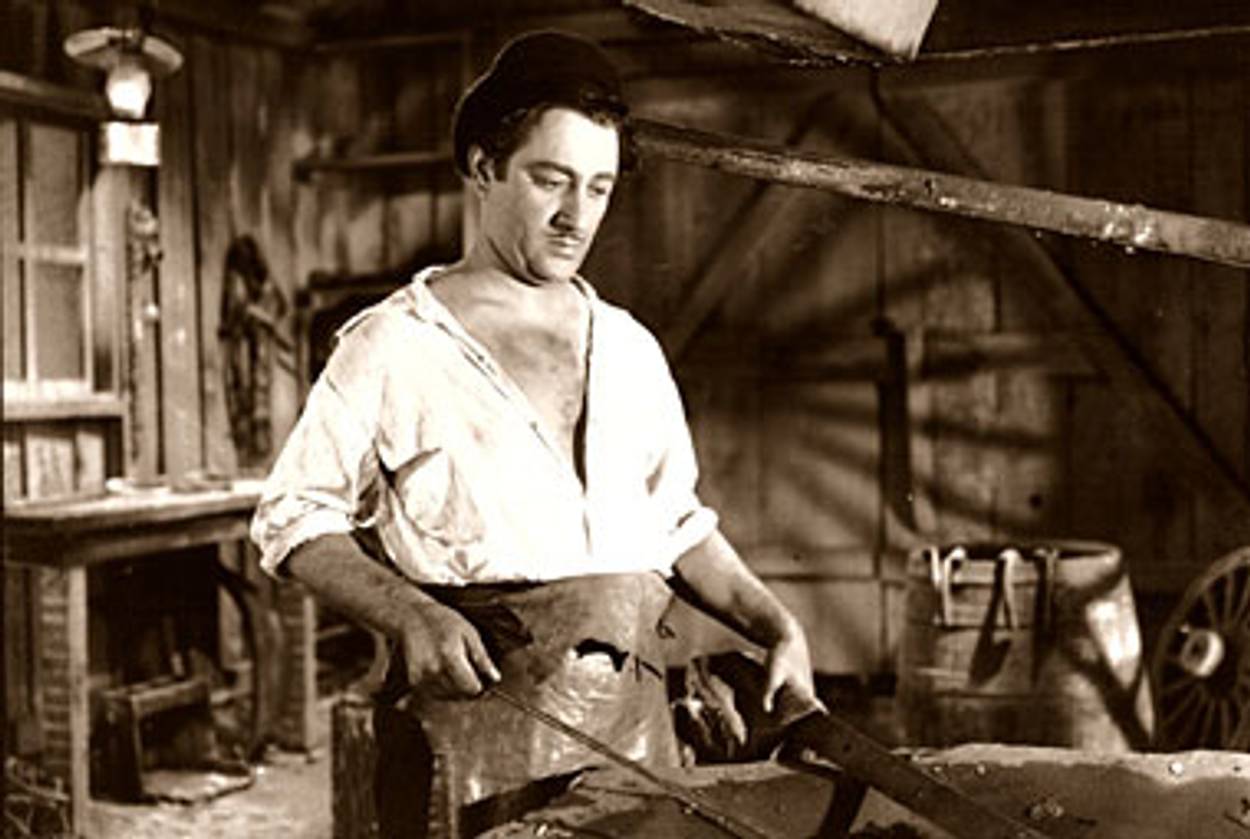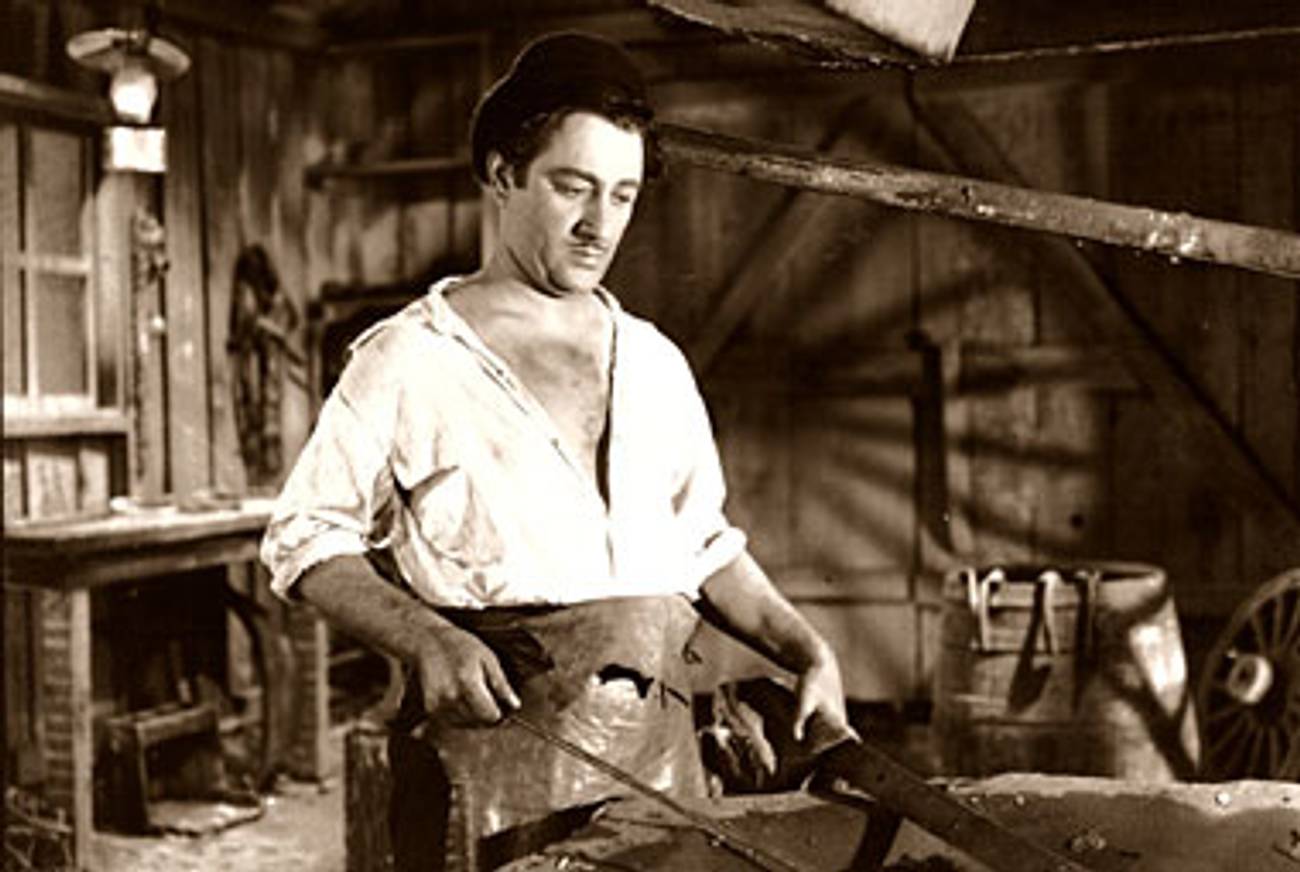Singing Sensation
Moishe Oysher, a midcentury cantor and performer, is enjoying an unexpected second act




If you follow the pop charts, you might have thought that Lady Gaga, Katy Perry, and Ke$ha are vying for the title of 2010’s biggest summer star. You’d have been wrong.
Last Tuesday, Village Voice film critic J. Hoberman presented a 1938 Yiddish film, The Singing Blacksmith, at a screening in Brooklyn. The singing blacksmith in question is played by Moishe Oysher, one of the great celebrity cantors and Yiddish movie stars of the World War II era, and from a show of hands taken by Hoberman, most of the few dozen film geeks in the audience had never heard of him before. Little did these trendsetters know they’d gotten in on the best micro-fad of the summer. A day after the screening and by total coincidence, Arik Luck, a young cantor in Chicago with a background in musical theater, released a live album of an all-Oysher musical revue he’d produced earlier this year. And next week (also by coincidence) a newly restored version of Oysher’s last picture, Singing in the Dark, will premiere at the Jerusalem International Film Festival. In a strange cosmic syzygy, Moishe Oysher is having a moment.
It’s particularly striking that the stars have aligned for Oysher, who died in 1958, because for many cantors alive today, it’s been a rough year. In February, the Jewish Theological Seminary, the Conservative movement’s flagship educational institution, folded its cantorial school into its rabbinical school, prompting cries of outrage from students and faculty. And a longtime movement in Conservative and Reform synagogues away from hazzanut and toward participatory singing has been exacerbated by the recession, which has prompted some cash-strapped shuls to have their rabbis do double duty as prayer leaders rather than hiring a cantor. At the same time, though, a resurgence of interest in the cantorial music of yore—less among synagogue-goers than among musicians—was recently given an endorsement by no less an eminence than violinist Itzhak Perlman, who, according to prominent klezmer musician Hankus Netsky, will be touring this year with Yitzhak Helfgot, one of today’s biggest cantorial stars.
“I think maybe we’re far enough away from the sound or the period that it sounds new again,” said Mark Slobin, a music professor at Wesleyan University. For younger musicians, he said, cantorial music “wasn’t some kitsch they had to sit through. It’s just kind of a sound, not an investment in an institutional structure.”
Enter Moishe Oysher—yes, that is said to be his given name—a charming, womanizing rogue whose own approach to “institutional structure” involved claiming that, as part of his vocal regimen, he had to smoke in synagogue. Born in Bessarabia in 1907, Oysher—whose story is told in Bridge of Light, Hoberman’s classic study of Yiddish cinema—performed in the Yiddish theaters of New York and Buenos Aires as a young man, but in his early thirties, desiring steady employment, he followed his father and several grandfathers before him into the cantorate. He quickly proved a divisive figure: His vocal chops earned him a job at the First Roumanian-American Congregation, a synagogue on Manhattan’s Lower East Side that was known as “the cantor’s Carnegie Hall,” but some congregants recoiled at the notion that a vaudevillian scamp was to lead them in prayer.
“You had people revoking their membership,” said Luck, who joined the staff of Beth Emet, a Reform temple in the Chicago suburb of Evanston, last summer. “People would come with him on Shabbos as witnesses to vouch that he wasn’t taking the train.”
Back on the 1930s Lower East Side, Oysher struck a deal with the local board of rabbis: He would try to rein in his excesses and would refrain from stage acting but would still be allowed to sing everything from cantorial hits to commercial jingles on the Yiddish radio and to pursue his dream of Hollywood stardom. He never made it into mainstream American cinema, but he did become one of the biggest names in Yiddish film. The Singing Blacksmith—which tells of a blacksmith who overcomes his low station and his own womanizing ways to win the hand of a beautiful maiden—was one of his three musicals in that language. (The movie is also known for its director, Edgar G. Ulmer, an Austrian Jewish émigré who made a number of “nationality films” for American immigrants in their native tongues. According to Hoberman, Ulmer constructed a set on the grounds of a New Jersey monastery that features as the shtetl in The Singing Blacksmith; a year later, he used the same “village,” onion domes looming in the background, for a Ukrainian film called Cossacks in Exile.)
Singing in the Dark, Oysher’s one English-language picture, was a 1956 genre hybrid about an amnesiac Holocaust survivor—and cabaret singer— pursued by gangsters. The National Center for Jewish Film, which previously restored Oysher’s Yiddish movies, will premiere its new version of the film next week. The film institute’s single most popular seller, according to its executive director Lisa Rivo, is a 2-disc set, Great Cantors of the Golden Age and Great Cantors in Cinema—both of which, of course, feature Oysher.
“You listen to a lot of classic cantorial music and it sounds very austere,” said Jeremiah Lockwood, frontman of The Sway Machinery, a band that draws on the sounds of hazzanut. Oysher, he said, “was a little bit slumming, there’s an extra vulgarism to his arrangements. There’ll be horns, maybe a little Latin percussion or something. My grandfather looks down on him as being a little bit of a huckster.”
Oysher did not become, like some of his cantorial contemporaries, an opera singer with highbrow gentile audiences; nor did he reach the pantheon of more “austere” celebrity cantors like Yossele Rosenblatt and Moshe Koussevitzky. But he may have had the last laugh. He’s been preserved on film the way no other cantor has, and if Luck gets his way, Oysher will finally make it to the real Carnegie Hall. Meanwhile, there’s no Koussevitzky fad in sight.
Marissa Brostoff, a doctoral student in English at the CUNY Graduate Center, is a former staff writer at Tablet and the Forward.
Ari M. Brostoff is Culture Editor at Jewish Currents.